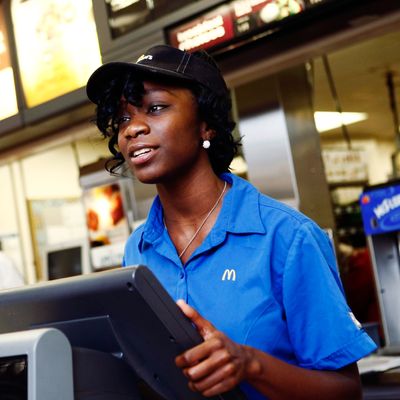
This month’s jobs report presents a conundrum. Of late, big company after big company after big company has announced pay increases. The economy is growing and employers are adding jobs, even if March produced something of a weather-related blip in the hiring numbers. But in aggregate, wages still aren’t rising. What gives?
It’s definitely a strange trend. In the past few months, a number of businesses have announced pay bumps — a sign that they need to compete to attract and retain employees, and thus a sign that the labor market really is heating up. The trend took hold last year, when basicwear giant Gap Inc. said it would raise its minimum hourly pay. Other firms followed, including Aetna, Ikea, Starbucks, Target, T.J. Maxx, and Walmart. And this week, we also got a big, fat McRaise. McDonald’s said that it would boost hourly employee pay to at least the local minimum wage, plus a dollar. By the end of 2016, the average hourly wage rate should be more than $10, the company said.
But alas, this business trend has not translated into a macroeconomic trend — at least not yet. Today, the government said that average hourly earnings have only climbed a little more than 2 percent over the past year. That’s a paltry figure, and there’s just no sign of sustained wage increases in the monthly report.
It seems that there are a few things going on. First off, the big pay bumps that have been announced, in truth, just are not that big. Take the McRaise. It applies to just 10 percent of the company’s domestic workforce. (That’s because the hike only goes into effect in stores that McDonald’s itself runs. Most of its outlets are operated by franchisees.) And it’s a small raise — just enough to for employees to nab something off the dollar menu every hour or two.
“They announced it on April Fools’ Day, and I really felt like it was a joke,” said Bleu Rainer, who works part-time at a McDonald’s in Tampa. “I was like, ‘For real?’ We want $15 an hour. We want union representation. We’re not playing with them. We want $15.” Getting $9 an hour would not change his ability to pay his rent or keep his lights on, he added. He’d still be scraping by in poverty.
Other companies’ raises have been bigger in scale and scope than the McRaise, to be fair. The pay hike offered by the Gap hit 72 percent of its workforce, according to data pulled together by the National Employment Law Project. Ikea’s hit about half of its employees, and Walmart’s about 40 percent. Walmart’s pay hike should cost the company about $1 billion a year, or 6 percent of its 2014 profits. In contrast, McDonald’s pay hike should only cost it around $100 million a year.
But all of these pay raises have been concentrated in low-wage sectors, muting their effect on the overall economy and helping explain why the headline number is not moving yet. Giving a 2 percent raise to a teenager flipping burgers for $8.25 an hour is a lot cheaper than giving a 2 percent raise to a dental assistant making $20 an hour, after all. And right now, it’s mostly the teenagers flipping burgers that are seeing those small bumps in their pay. As The Wall Street Journal notes, wages have climbed 3.6 percent in the generally low-wage leisure and hospitality industries. They have climbed only 1.9 percent in education and health, where there are millions of middle-class and upper-middle-class jobs.
There’s also a bit of a telescoping going on in the media, I fear. Back in the economic expansions of the 1990s and 2000s, companies rarely felt the need to trumpet the news when they offered their workers a few more quarters and nickels per hour. Now — given the high-profile Fight for $15 campaign and the broader cultural attention paid to inequality — they do. Bizarrely, all of the attention on the plight of low-wage workers might make these raises seem like a bigger deal than they are. “The announcement from McDonald’s — it was PR stunt,” said Kendall Fells, the Fight for $15’s organizing director. “It’s laughable. But the workers have more momentum now than ever.”
That’s the thing. Even if these changes have not shown up in the aggregate numbers yet, they are indicative that companies are competing a little harder to bring in and keep employees. They are a sign that the economy is getting better. They might show that external pressure helps corporations do the right thing. And they do mean that hundreds of thousands of workers should be seeing a little more take-home pay.
At some point, the data should catch up with the headlines.





























